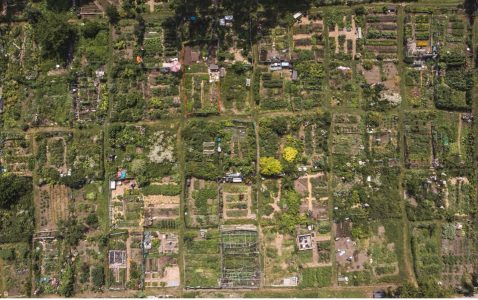Author: Savanna Batson, MPA, is a public administration professional with a background in policy research, program development and public sector collaboration. She holds a Master of Public Administration from Texas State University. She can be reached at [email protected].
Widgetized Section
Go to Admin » Appearance » Widgets » and move Gabfire Widget: Social into that MastheadOverlay zone
Overcoming Institutional Inertia Through Communities of Practice
The views expressed are those of the author and do not necessarily reflect the views of ASPA as an organization.
By Savanna Batson
June 13, 2025

By design, public organizations are slow to change. As responsible stewards of public funds, convention and proven methodology provide reliable standards to follow to ensure that projects and programs produce desired results. However, this can make change difficult to achieve.
Green and blue infrastructure, which can be loosely defined as nature-based strategies for addressing environmental challenges to the built environment, spring to mind as examples of a field of practice whose uptake has been fairly slow due to its relatively new implementation. While the benefits of these approaches are generally accepted, quantifying the benefits of green and blue infrastructure for cost-benefit analysis is mathematically challenging due to site-specific differences in anticipated air, water and soil quality benefits due to the complex localized specifications of those qualities, and the size and scale of the challenge begins to take shape.
In the water sector, where blue infrastructure encompasses water quality enhancements provided by such strategies as bioretention ponds, bioswales and permeable pavements and water quantity enhancements provided by rainwater harvesting, water reuse and managed aquifer recharge (MAR), progress toward implementing these strategies has been slow. However, it may now be gathering speed, which is fortuitous timing in the face of prolonged periods of drought and intensifying climate variability.
Such advances toward more widespread uptake of these strategies in Texas can be seen in the state’s draft Regional Water Plans, which are due to be consolidated by the Texas Water Development Board into the State Water Plan in 2027. There, green and blue infrastructure are present in aquifer storage and recovery (a type of MAR) projects, constructed wetlands and regional approaches to shared community and water system challenges. These approaches figure notably, though not predominantly, among proposed strategies to address aging infrastructure and concerns about water scarcity.
While the concepts of green and blue infrastructure and regionalization—which is a blanket term that includes resource-sharing, formal and informal agreements and physical consolidation—are not new, scaled implementation of them to meet demand for resilient, sustainable development proves challenging. And while the co-benefits of green and blue infrastructure and regional collaboration are numerous, institutionalizing the equitable implementation of these projects has proven challenging.
One means of helping to overcome institutional inertia that slows efforts to innovate and to subsequently develop best practices is communities of practice. Étienne Wenger and anthropologist Jean Lave first coined the phrase in 1991 while studying apprenticeship as a learning model; Wenger subsequently defines a community of practice as “groups of people who share a concern or a passion for something they do and learn how to do it better as they interact regularly.”
Additionally, Wenger notes that a community of practice is composed of a relatively stable group of people who meet in person and who work in close proximity to one another; furthermore, identity formation and negotiation of meaning, which are developed through participation, are central features for learning and the creation of knowledge. The University of California at Berkeley summarizes these characteristics with the following elements: 1) joint enterprise 2) mutual engagement 3) shared repertoire 4) negotiation of meaning 5) participation and 6) identity (positionality).
Ash Amin and Joanne Roberts (2008) note a certain drift in the application of the term in the decades following Wenger’s and Lave’s original publication, leading to their heuristic of four overarching typologies of “knowing in action” that loosely group participants by the type of knowledge that is being shared. This distinction highlights the wide-ranging applicability of communities of practice as a model for learning, which is particularly relevant in public administration, where local governments and their not-for-profit partners are composed of diverse, dynamic individuals with wide-ranging fields of expertise. And as we know, most projects proceed on the basis of coordination and collaboration.
One case study from the state of Western Australia finds that a community of practice consisting of members from two government departments and a community organization was critical in enabling the state government’s public inquiry into climate change (Wrigley et al, 2024). From this inquiry came a range of new policies, strategies and the climate policy subsystem. Other research on the Wellbeing of Future Generations (Wales) Act of 2015 led to the creation of a novel program that explicitly seeks to enhance public service organizations’ innovation capabilities (Walpole et al, 2022). Rather than seeking increased funding, an increasingly challenging sell in today’s federal funding landscape, the Circular Economy Innovation Community sought to advance innovation in the public sector through inter-organization communities of practice.
In both cases, the community of practice is recognized for its facility as a great repository of tacit knowledge, which can provide stability and resources in the event of employee turnover. More importantly, these examples of communities of practice shift the locus of technical knowledge from individuals with specialized knowledge to a community of peers from different locales and backgrounds. Not without some friction, communities of practice allow practitioners to more readily strategize solutions to common challenges, ease the gridlock of institutional inertia and reify the potential for justice and equitable participation in pursuit of innovation.


Follow Us!